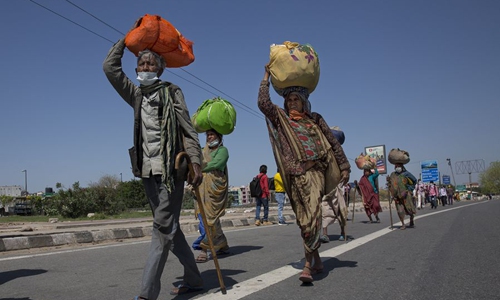HOME >> WORLD
Modi lockdown reveals lack of COVID-19 preparedness
By Sun Haoran Source:Global Times Published: 2020/4/3 6:45:59

Migrant laborers walk to their villages during the lockdown in New Delhi, India, on March 29. Photo: Xinhua
Chaos and hunger in migrant communities along with police abuse have reduced the effectiveness of the lockdown measures taken by the Indian government, with Chinese experts noting such harsh actions reveal the Modi administration wasn’t well-prepared, which could accelerate the spread of the novel coronavirus (COVID-19).
On Thursday, India confirmed 2,100 COVID-19 cases and 60 fatalities as global infections approached one million.
Asia’s largest slum, Dharavi, Mumbai, reported its first COVID-19 fatality involving a 56-year-old garment shop owner, who had not traveled, The Economic Times reported.
“This is definitely not a good sign,” Qian Feng, a senior fellow with the Taihe Institute and director of the research department of the National Strategy Institute under Tsinghua University, told the Global Times.
“The slums in India are extremely congested and have very poor sanitary conditions and health facilities,” said Qian and added, “once a coronavirus outbreak occurs in such places, it would cause a humanitarian catastrophe.”
The victim was a resident at D. Baliga Nagar SRA society that has around 300 flats, all of which have been sealed, as well as 90 nearby shops. Local authorities have also stamped and quarantined those who had come in contact with the victim.
India experienced a jump in COVID-19 cases as data revealed an increase of 386 on Wednesday.
Although Prime Minister Narendra Modi ordered a 21-day lockdown for India’s 1.3 billion population, chaos and hunger among the lower classes have rendered his efforts ineffective.
“We can’t go out to work so there is little that we can do to make ends meet. There are around 5,000 workless laborers here, but food is distributed for 300 people,” Mohammad Shahnawaz, a 25-year-old in south Delhi’s Khirki E Extension.
BBC said millions of migrant workers were fleeing shuttered cities and trekking home to their villages because their workplaces were shut and most employees and contractors who paid them vanished due to the lockdown.
Videos uploaded onto social media show Indian policemen using their batons to beat vegetable traders and drivers, or making lockdown violators do squats and leapfrog as punishment, according to AFP.
Although some netizens supported the police actions, while many criticized the policemen for abusing their power.
“There are huge gaps between India and some developed countries, such as the US, Italy and France, in terms of public healthcare system, testing levels and financial capability,” Lan Jianxue, deputy director of the Department for Asia-Pacific Studies at China Institute of International Studies, told the Global Times.
It was also reported that only 47,951 tests had been done and with only 51 government-approved testing centers across India.
“Plus, a lot of people are still not aware of this deadly disease and some believers even going out to attend religious activities at this crucial period. Indian government was forced to take drastic measures to prevent a possible disaster,” said Lan.
Lan felt the harsh lockdown indicated the Modi administration wasn’t ready to handle the pandemic.
Qian explained the main problem with the lockdown is that the Indian government didn’t carry out specific measures for different groups of people.
“For example, the middle class and above can tolerate no payment temporarily and they have relatively good living and sanitation conditions, whereas a large number of migrant workers would be greatly affected economically, no need to mention those who do not even have a fixed place to live, but only return to their hometown,” Qian noted.
Qian added that India is limited by transportation capacity. Also, migrants workers could become refugees if their hometowns block them from returning.
China said it is willing to share with India its experience in fighting COVID-19 and to provide possible aid, spokesperson for China's Ministry of Foreign Affairs Hua Chunying said on Wednesday, which marked the 70th anniversary of diplomatic ties between the two countries.
RELATED ARTICLES:
Posted in: CENTRAL & SOUTH ASIA